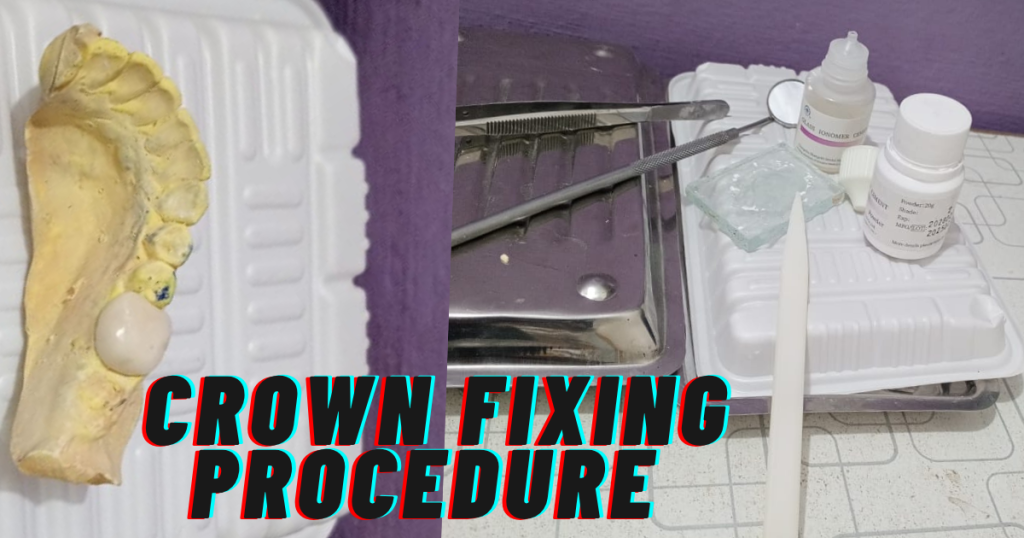Physical Address
304 North Cardinal St.
Dorchester Center, MA 02124
Physical Address
304 North Cardinal St.
Dorchester Center, MA 02124
Have you ever wondered what happens when your dentist recommends a dental crown? If the thought of the procedure feels overwhelming or mysterious, you’re not alone—many people feel the same way! In this easy-to-follow guide, we’ll break down the crown fixing process step by step, from preparation to the final result, using simple language and helpful tips to put your mind at ease. Whether you’re preparing for your first crown or just curious about restoring your smile, get ready to discover how this common treatment can bring back comfort, function, and confidence to your teeth.

What Exactly Is a Dental Crown?
A dental crown is basically a cap that covers a damaged tooth. It’s shaped like your natural tooth and made from materials like porcelain, metal, or ceramic. Think of it as a protective helmet for your tooth—it shields what’s left after decay, cracks, or breaks. Crowns aren’t just for fixing problems; they can also improve how your teeth look, especially if you’ve got discoloration or odd shapes.
When Do You Need a Crown?
Crowns come into play for several reasons. If a tooth is badly decayed and a filling won’t cut it, a crown steps in to save the day. They’re also great after root canals, where the tooth might be weakened. Got a cracked tooth from biting something hard? Or maybe you want to cover an implant or bridge a gap? Your dentist will check things like X-rays and bite alignment to decide if it’s right for you. It’s all about preventing further damage and keeping your smile strong.
Different Types of Crowns to Choose From
Not all crowns are the same—options depend on your needs and budget. Porcelain crowns blend seamlessly with your teeth for a natural look, ideal for front teeth. Metal crowns, like gold or alloy, are super durable but more noticeable, so they’re often used in the back. Then there’s porcelain-fused-to-metal, which combines strength and aesthetics. Ceramic ones are popular for their hypoallergenic properties. Talk to your dentist about what’s best; factors like allergies or grinding habits play a role.
Step-by-Step: The Crown Fixing Process
Let’s dive into the main event. The process usually takes two visits, but it’s straightforward.
First, preparation. Your dentist numbs the area and reshapes the tooth to make room for the crown. They’ll remove any decay and file down the sides—it’s like sculpting for a perfect fit.
Next, impressions. They take a mold of your tooth using putty or a digital scanner. This goes to a lab where your custom crown is crafted. It might take a week or two.
While waiting, you’ll get a temporary crown. It’s made from acrylic and protects the tooth. Be gentle with it—no sticky foods!
Finally, the fixing appointment. The dentist removes the temp, checks the permanent crown’s fit and color, then cements it in place. A quick bite check, and you’re done. Modern tech like same-day crowns (using CAD/CAM) can wrap it up in one visit at some clinics.
What to Expect: Comfort and Time
Most folks find the procedure comfy thanks to local anesthesia—no pain during the work. You might feel some sensitivity afterward, but it fades. Each visit lasts about an hour. If you’re anxious, ask about sedation options. Pro tip: Bring headphones for tunes to relax.
Aftercare for a Lasting Crown
Once fixed, treat your crown like a natural tooth—brush twice daily, floss around it, and use a soft toothbrush. Avoid hard candies or ice chewing to prevent chips. Regular check-ups every six months keep everything in top shape. With good care, crowns can last 10-15 years or more.
Possible Risks and How to Handle Them
Like any dental work, there are minor risks. The tooth might feel sensitive to hot or cold at first. Rarely, the crown could loosen or crack, but that’s fixable. If you notice swelling or pain that sticks around, call your dentist right away. Infections are uncommon with proper hygiene.
FAQs About Crown Fixing
How much does it cost?
It varies—$800 to $2,500 per crown, depending on material and location. Insurance often covers part if it’s medically needed.
Does it hurt?
Not really during the procedure, but some soreness after is normal. Over-the-counter pain relievers help.
Can I eat normally right away?
With a temporary crown, stick to soft foods. Once permanent, you’re good for most things—just ease in.
What’s the difference between a crown and a veneer?
Veneers are thin shells for the front of teeth, mainly cosmetic. Crowns cover the whole tooth for structural support.
How do I know if my crown needs replacing?
Watch for looseness, discomfort, or visible wear. Your dentist will spot issues during exams.
Understanding the crown fixing process doesn’t have to be intimidating—it’s a reliable way to restore your tooth’s strength and beauty with minimal hassle. Armed with this knowledge, you’re better prepared to discuss options with your dentist and make informed choices for your oral health. Remember, a healthy smile boosts your confidence and well-being, so don’t hesitate to seek professional advice if you’re dealing with tooth issues